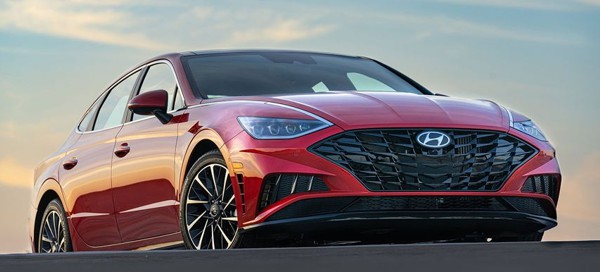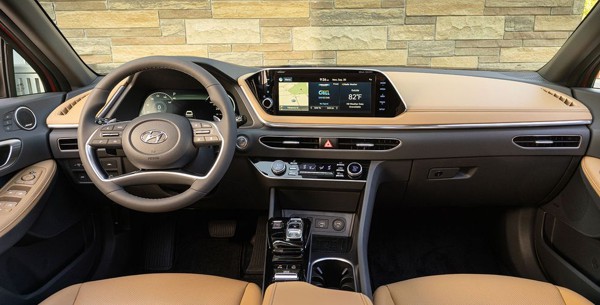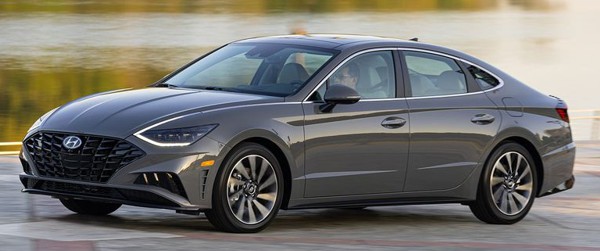Published
on 24
Mar 2020
|
All rights reserved.
|
|
|

|
|
The
fire-breathing grilles and vents are unnecessary for any cars with
performance less than a GT-R...
|
|
Sensuous Sportiness,
that’s the new design theme of Hyundai. The first concept car to
preview this theme was the Le Fil Rouge coupe demonstrated in the 2018
Geneva motor show. It was beautifully shaped, thanks to flowing and
sexy lines that contrasted to the industry’s design trend. As the
concept was not destined to production, it captured little attention,
but at the same time Hyundai’s designers were working behind the scene
to put the same design theme to production models. The first fruit is
Sonata.
Mid-size family car segment used to be filled with boring and
conservative designs. This is no longer the case today. Manufacturers
generally take design more seriously than a decade ago, spending
enormous money to their studios, hiring designers and exploring new
design directions. Still, some do better than others. Mazda 6, Kia
Optima / K5 and Renault Talisman are good. VW Passat and Skoda Superb
are not so superb. Nissan Altima and Toyota Camry are somewhat over the
top. Honda Accord and Ford Fusion / Mondeo are outdated by now. Under
the leadership of Peter Schreyer, Hyundai-Kia group is generally
performing better than the rest of the industry. Seeing the new Sonata
could only strengthen our belief that the Korean group will be a
formidable player in an automotive world that focusing more and more on
design and innovation.

|
|
As
long as forms don't compromise functions, why not more aggressive?
|
|
The Sonata is a radical design, no less than the Altima or Camry.
However, it is also more tasteful and elegant. The most controversial
element is the massive, fire-breathing front grille that might be
mistaken for an Aston Martin – and I mean Zagato. Yes, it is that
aggressive. You might say it is flamboyant, as the Sonata’s small
engines need little cooling, so more than half of the grill is actually
sealed. Equally pretentious are the brake intakes and vents at either
side of the front bumper. They are absolutely unnecessary for any cars
with performance less than a GT-R. Okay, so it is pretentious, but so
what? As long as people love and buyers feel good, why not? In my
childhood, a lot of Japanese cars have stickers like “DOHC 16-VALVE
INTERCOOLED TURBO 4WS 4WD” (yes, I am talking you, Mitsubishi Galant
VR4), or many people put the M-badge on their BMW 318i. Who says cars
shall be as understated as an Audi S6 ? As long as forms don’t
compromise functions, I don’t care. The new Sonata has an excellent Cd
of 0.27, so the fire-breathing grille is just a bonus.
This is a sporty-looking design not just because of its aggressive
grille, but a sleek silhouette that mimics a coupe. The nose and tail
are tapered. The bonnet is curvy. The A and C-pillars are set at fast
angle, although not necessarily faster than the last Sonata. The
flowing waist line of Le Fil Rouge emerges here. There are some elegant
design details, most notably the chrome line that runs along the bonnet
edge and joins the LED stripe at the lower edge of headlamp. The sharp
taillights and the way it merges with boot lid is also a great success.
The Sonata is unquestionably a very stylish car.

|
|
Sensuous
Sportiness design theme is introduced on the Sonata.
|
|
It is also a rather large car in the class. Measuring 4900mm long,
1860mm wide and 2840mm in wheelbase, it is significantly larger than
the last generation, and slightly larger than Honda Accord and Toyota
Camry as well. This gives its interior plenty of space for 6-footers,
no matter front or rear. Boot space is also competitive.
The interior feels airy, thanks to large windows and slim pillars, also
because all occupants sit higher. To the driver, the elevated seating
position is not that sporty. However, the environment he faces feels
good. The dashboard is low, wide and slick in design. Soft-padded
surfaces are aplenty on the higher spec. models, which looks and feels
more luxurious than most rivals. The large, 10.25-inch center
touchscreen is well integrated with the dashboard. Its resolution,
response and software are good. The instrument pod looks less
attractive, especially with cheap-looking analogue dials on lower spec
models, but premium trims change to a digital display. Conventional
gear shifter is replaced by 4 buttons for the same function, while
gearshift is taken care by paddles. Seating position aside, this cabin
has nothing to complain about.
 |
|
The
cabin is spacious and feels more expensive than most rivals.
|
|
The underpinning platform is said to be new, but Hyundai makes no
special statement except saying its suspension subframes are
strengthened. The suspension continues to be MacPerson struts up front
and multi-link setup at the back. Unlike Honda Accord, there seems to
be not much aluminum used in the suspension. Nor adaptive dampers are
offered. Nor hydraulic bump stops. The Sonata seems to take chassis
dynamics and refinement less seriously than Honda, although it is not
alone in the family car segment. That said, few rivals adopt about
glazing
windows like it.
On the road, the Sonata rides and handles nothing like its sporty look
suggested. Make no mistake, this is still a conventional family car,
with no intention to be a class leader of dynamics. It corners
predictably, rolls and understeers gently in corner. Body control and
grip are no better than average. The steering is light and not
communicative enough to inspire excitement. Ride quality is generally
good, but on rougher surfaces it becomes floaty. The 18-inch wheels
with 235/45 tires on top spec model makes the ride quite brittle and
noisy. Moreover, at high speed excessive wind noise is penetrated from
the window frames, proving that the double glazing is an afterthought.

|
|
Driving
dynamics is not quite as sporty as its looks suggested...
|
|
At launch, the Sonata offers a 1.6-liter direct-injection turbo engine
with 180hp and 195 lbft of torque. It is not the long-serving unit
appeared on many other Hyundai and Kia models, but an all-new
development, with different bore and stroke dimension and, most
importantly, an innovative continuous
variable valve duration (CVVD) technology which Hyundai claims to
boost performance by 4% and fuel economy by 5%, accompanied with lower
emissions. Frankly, the benefits are not detectable. Like most
turbocharged motors, it feels torquey from very low revs and strong at
the mid-range, never needs to scream for acceleration, but it is
neither especially sweet to rev nor faster than rivals. Performance is
about mid-pack, trailing the lighter yet more powerful Honda Accord
1.5T. Its EPA fuel economy is 31mpg combined, losing to the Honda’s
33mpg. The company’s claim is not materialized.
Another engine is a 2.5-liter naturally aspirated GDI engine, also a
new design. Strangely, despite selling as a base engine at $2000 less,
it produces more power at 191hp, although with less torque across the
range. Fuel economy is identical to the 1.6 Turbo, making the latter
more embarrassing. Both engines mate with Hyundai’s 8-speed automatic
transmission whose operation is generally faultless, if you don’t rush.
In Korea, the base engine is a 1.6 GDI with 160hp, mated with a 6-speed
automatic. As before, a hybrid model is offered alongside the
conventional Sonata. It combines the 1.6 GDI engine with an electric
motor for a system output of 192hp.
Though not very quick, the Sonata avoids accidents smartly, because has
many safety features, such as collision avoidance, adaptive cruise
control with lane keeping, driver attention warning etc. As always, it
is a value-packed car, though now also packed with a great exterior and
interior packaging.
|
Verdict:     |
Published
on 8
Feb 2021
|
All rights reserved.
|
|
Sonata N-line
|
|

|
|
Not
a true N model, but a wise choice.
|
|
Well, this is not a true N
model, but the warm N-line. Surprisingly, it gets a lot of power. The
engine starts life from the 2.5-liter four-pot, added with a
turbocharger which is integral with exhaust manifold, boosting output
to 290 horsepower. Torque delivery is even more remarkable, peaking at
311 lbft from 1650 rpm all the way to 4000 rpm. There is little turbo
lag to speak of, although its sound is no better to listen than most
other big fours. It works with Hyundai’s new 8-speed DCT, which
operates with wet clutches of course, to deliver smooth and responsive
power to the front wheels.
Yes, front wheels. And there is neither a limited slip differential nor
sophisticated front suspensions, which remains to be ordinary
MacPherson struts. Instead, Hyundai fits it with stiffer springs,
dampers, anti-roll bars, suspension bushings and stiffer engine mounts,
in addition to uprated brakes and 19-inch wheels wrapped with 245/40
summer tires. Besides, the power steering has been upgraded from
column-mounted motor to dual-pinion type.
The result? The Sonata N-line storms from rest to 60 mph in just over 5
seconds, beating any mainstream family sedans. If you want comparable
performance, you’ll need at least a Kia Stinger GT (V6 power), which is
considerably more expensive. German sports saloons are more expensive
still. What competes directly with the Hyundai is Toyota Camry V6,
which takes half a second longer and feels no way as responsive. In
terms of straight line performance, the Sonata N is King of its class.
In corner, it is good up to a point. If you drive it in the way most
family car drivers would do, you may appreciate its abundance of grip,
its precise steering, surefooted brakes and progressive control of body
roll without worsening ride comfort too much. The work of ex-BMW M boss
Albert Biermann is evident here. However, if you push harder and assume
you were driving an N, M, AMG or whatever hot, you will find some
torque steer happening whenever you are heavy on throttle. Switch to
the most aggressive Sport+ mode will disengage ESP, and you can easily
spin the inside front wheel in first, second and third gear. This motor
is too powerful for the chassis to take on.
To satisfy keen drivers, the N-line needs at least an LSD and sportier
suspension setting, but then it will become an N model, selling at
elevated prices yet its front-wheel-drive chassis still failing to
match European premium labels. That’s why Hyundai would rather leave it
in the sweet spot.
|
Verdict:    |
|